Wei Meng
Aerial Target Encirclement and Interception with Noisy Range Observations
Aug 11, 2025Abstract:This paper proposes a strategy to encircle and intercept a non-cooperative aerial point-mass moving target by leveraging noisy range measurements for state estimation. In this approach, the guardians actively ensure the observability of the target by using an anti-synchronization (AS), 3D ``vibrating string" trajectory, which enables rapid position and velocity estimation based on the Kalman filter. Additionally, a novel anti-target controller is designed for the guardians to enable adaptive transitions from encircling a protected target to encircling, intercepting, and neutralizing a hostile target, taking into consideration the input constraints of the guardians. Based on the guaranteed uniform observability, the exponentially bounded stability of the state estimation error and the convergence of the encirclement error are rigorously analyzed. Simulation results and real-world UAV experiments are presented to further validate the effectiveness of the system design.
AR-LIF: Adaptive reset leaky-integrate and fire neuron for spiking neural networks
Jul 28, 2025Abstract:Spiking neural networks possess the advantage of low energy consumption due to their event-driven nature. Compared with binary spike outputs, their inherent floating-point dynamics are more worthy of attention. The threshold level and reset mode of neurons play a crucial role in determining the number and timing of spikes. The existing hard reset method causes information loss, while the improved soft reset method adopts a uniform treatment for neurons. In response to this, this paper designs an adaptive reset neuron, establishing the correlation between input, output and reset, and integrating a simple yet effective threshold adjustment strategy. It achieves excellent performance on various datasets while maintaining the advantage of low energy consumption.
WSCIF: A Weakly-Supervised Color Intelligence Framework for Tactical Anomaly Detection in Surveillance Keyframes
May 14, 2025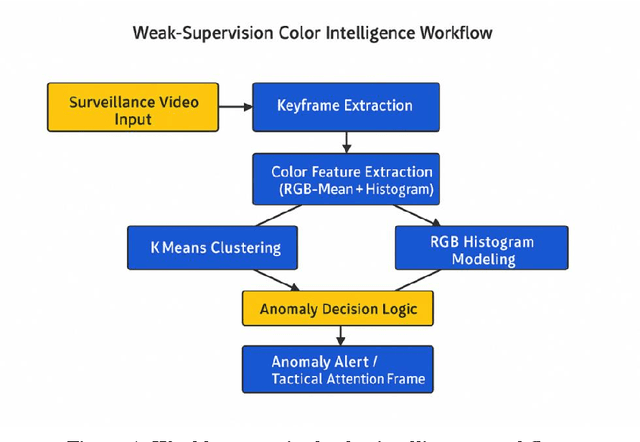

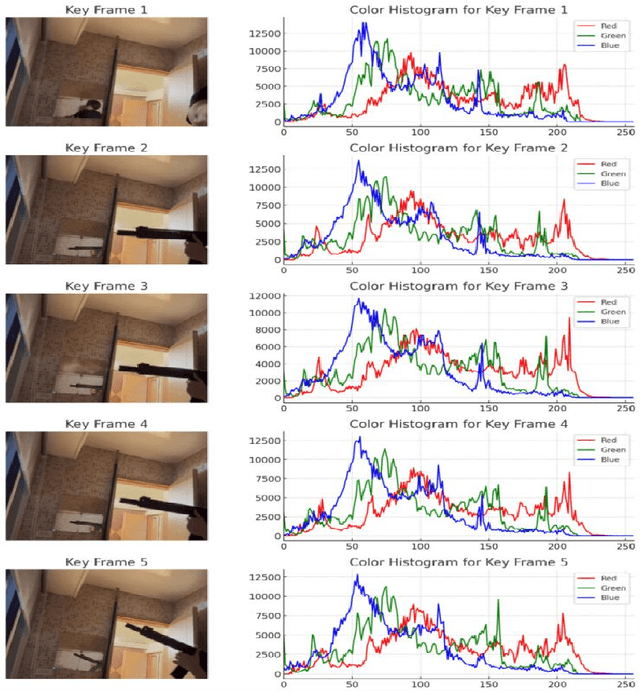
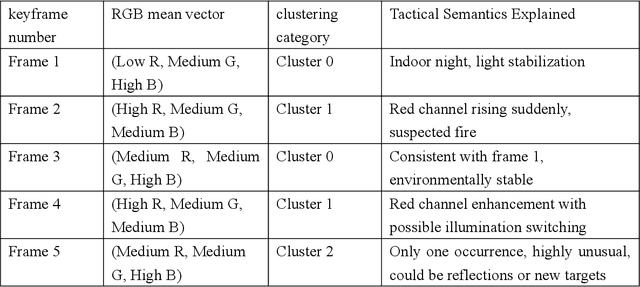
Abstract:The deployment of traditional deep learning models in high-risk security tasks in an unlabeled, data-non-exploitable video intelligence environment faces significant challenges. In this paper, we propose a lightweight anomaly detection framework based on color features for surveillance video clips in a high sensitivity tactical mission, aiming to quickly identify and interpret potential threat events under resource-constrained and data-sensitive conditions. The method fuses unsupervised KMeans clustering with RGB channel histogram modeling to achieve composite detection of structural anomalies and color mutation signals in key frames. The experiment takes an operation surveillance video occurring in an African country as a research sample, and successfully identifies multiple highly anomalous frames related to high-energy light sources, target presence, and reflective interference under the condition of no access to the original data. The results show that this method can be effectively used for tactical assassination warning, suspicious object screening and environmental drastic change monitoring with strong deployability and tactical interpretation value. The study emphasizes the importance of color features as low semantic battlefield signal carriers, and its battlefield intelligent perception capability will be further extended by combining graph neural networks and temporal modeling in the future.
A study on audio synchronous steganography detection and distributed guide inference model based on sliding spectral features and intelligent inference drive
May 06, 2025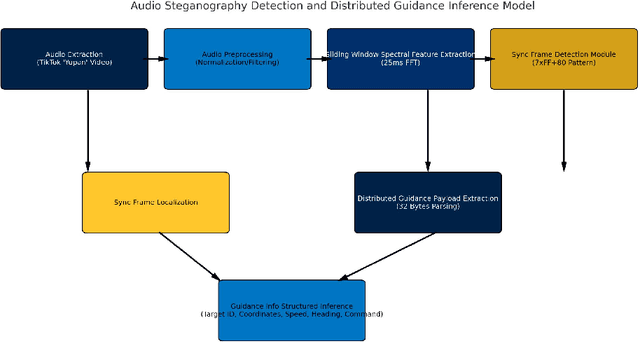
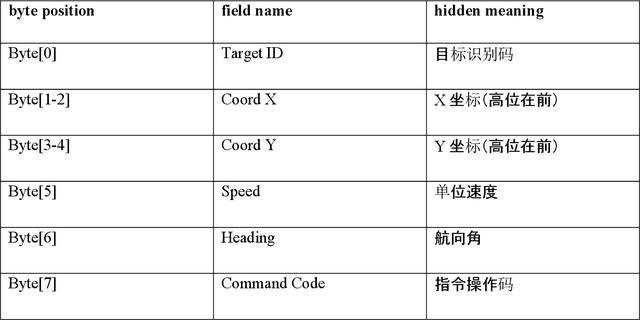
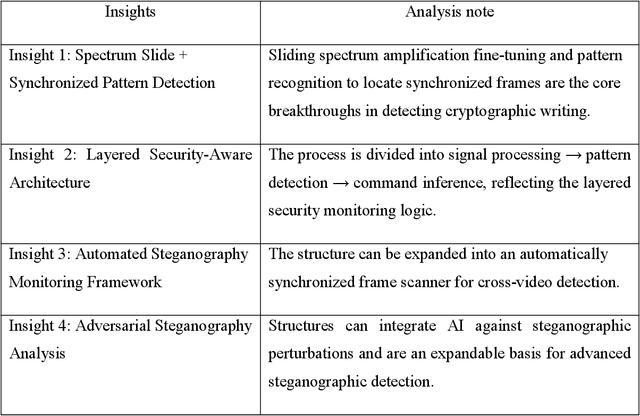
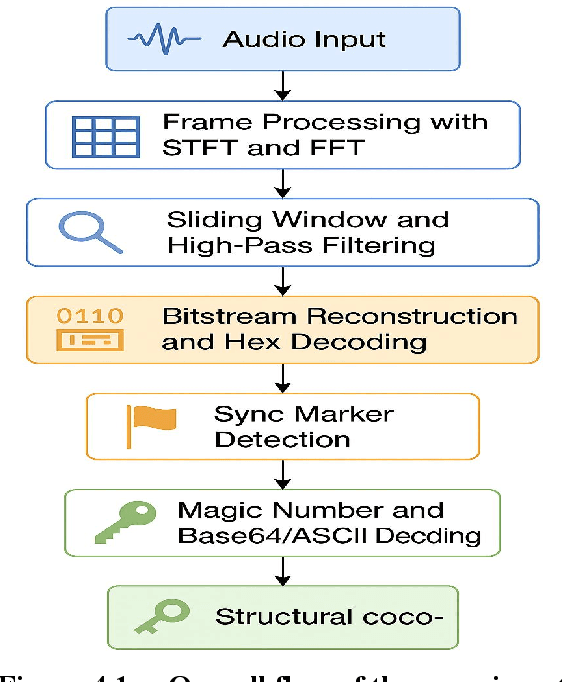
Abstract:With the rise of short video platforms in global communication, embedding steganographic data in audio synchronization streams has emerged as a new covert communication method. To address the limitations of traditional techniques in detecting synchronized steganography, this paper proposes a detection and distributed guidance reconstruction model based on short video "Yupan" samples released by China's South Sea Fleet on TikTok. The method integrates sliding spectrum feature extraction and intelligent inference mechanisms. A 25 ms sliding window with short-time Fourier transform (STFT) is used to extract the main frequency trajectory and construct the synchronization frame detection model (M1), identifying a frame flag "FFFFFFFFFFFFFFFFFF80". The subsequent 32-byte payload is decoded by a structured model (M2) to infer distributed guidance commands. Analysis reveals a low-entropy, repetitive byte sequence in the 36 to 45 second audio segment with highly concentrated spectral energy, confirming the presence of synchronization frames. Although plaintext semantics are not restored, the consistency in command field layout suggests features of military communication protocols. The multi-segment splicing model further shows cross-video embedding and centralized decoding capabilities. The proposed framework validates the effectiveness of sliding spectral features for synchronized steganography detection and builds an extensible inference model for covert communication analysis and tactical guidance simulation on open platforms.
Modeling supply chain compliance response strategies based on AI synthetic data with structural path regression: A Simulation Study of EU 2027 Mandatory Labor Regulations
May 04, 2025Abstract:In the context of the new mandatory labor compliance in the European Union (EU), which will be implemented in 2027, supply chain enterprises face stringent working hour management requirements and compliance risks. In order to scientifically predict the enterprises' coping behaviors and performance outcomes under the policy impact, this paper constructs a methodological framework that integrates the AI synthetic data generation mechanism and structural path regression modeling to simulate the enterprises' strategic transition paths under the new regulations. In terms of research methodology, this paper adopts high-quality simulation data generated based on Monte Carlo mechanism and NIST synthetic data standards to construct a structural path analysis model that includes multiple linear regression, logistic regression, mediation effect and moderating effect. The variable system covers 14 indicators such as enterprise working hours, compliance investment, response speed, automation level, policy dependence, etc. The variable set with explanatory power is screened out through exploratory data analysis (EDA) and VIF multicollinearity elimination. The findings show that compliance investment has a significant positive impact on firm survival and its effect is transmitted through the mediating path of the level of intelligence; meanwhile, firms' dependence on the EU market significantly moderates the strength of this mediating effect. It is concluded that AI synthetic data combined with structural path modeling provides an effective tool for high-intensity regulatory simulation, which can provide a quantitative basis for corporate strategic response, policy design and AI-assisted decision-making in the pre-prediction stage lacking real scenario data. Keywords: AI synthetic data, structural path regression modeling, compliance response strategy, EU 2027 mandatory labor regulation
CVVNet: A Cross-Vertical-View Network for Gait Recognition
May 03, 2025Abstract:Gait recognition enables contact-free, long-range person identification that is robust to clothing variations and non-cooperative scenarios. While existing methods perform well in controlled indoor environments, they struggle with cross-vertical view scenarios, where surveillance angles vary significantly in elevation. Our experiments show up to 60\% accuracy degradation in low-to-high vertical view settings due to severe deformations and self-occlusions of key anatomical features. Current CNN and self-attention-based methods fail to effectively handle these challenges, due to their reliance on single-scale convolutions or simplistic attention mechanisms that lack effective multi-frequency feature integration. To tackle this challenge, we propose CVVNet (Cross-Vertical-View Network), a frequency aggregation architecture specifically designed for robust cross-vertical-view gait recognition. CVVNet employs a High-Low Frequency Extraction module (HLFE) that adopts parallel multi-scale convolution/max-pooling path and self-attention path as high- and low-frequency mixers for effective multi-frequency feature extraction from input silhouettes. We also introduce the Dynamic Gated Aggregation (DGA) mechanism to adaptively adjust the fusion ratio of high- and low-frequency features. The integration of our core Multi-Scale Attention Gated Aggregation (MSAGA) module, HLFE and DGA enables CVVNet to effectively handle distortions from view changes, significantly improving the recognition robustness across different vertical views. Experimental results show that our CVVNet achieves state-of-the-art performance, with $8.6\%$ improvement on DroneGait and $2\%$ on Gait3D compared with the best existing methods.
Non-cooperative Stochastic Target Encirclement by Anti-synchronization Control via Range-only Measurement
Feb 08, 2025Abstract:This paper investigates the stochastic moving target encirclement problem in a realistic setting. In contrast to typical assumptions in related works, the target in our work is non-cooperative and capable of escaping the circle containment by boosting its speed to maximum for a short duration. Considering the extreme environment, such as GPS denial, weight limit, and lack of ground guidance, two agents can only rely on their onboard single-modality perception tools to measure the distances to the target. The distance measurement allows for creating a position estimator by providing a target position-dependent variable. Furthermore, the construction of the unique distributed anti-synchronization controller (DASC) can guarantee that the two agents track and encircle the target swiftly. The convergence of the estimator and controller is rigorously evaluated using the Lyapunov technique. A real-world UAV-based experiment is conducted to illustrate the performance of the proposed methodology in addition to a simulated Matlab numerical sample. Our video demonstration can be found in the URL https://youtu.be/JXu1gib99yQ.
Multiple noncooperative targets encirclement by relative distance-based positioning and neural antisynchronization control
Nov 13, 2024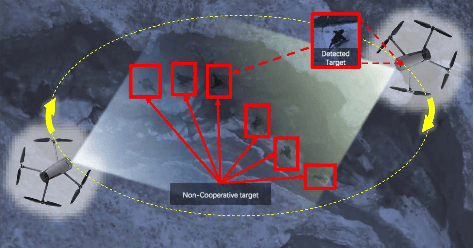

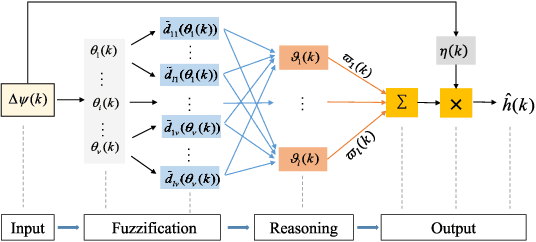
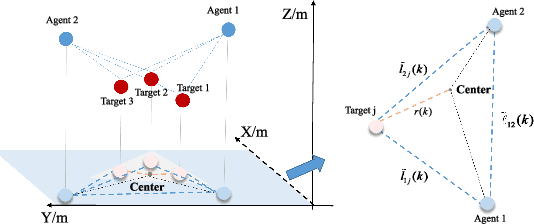
Abstract:From prehistoric encirclement for hunting to GPS orbiting the earth for positioning, target encirclement has numerous real world applications. However, encircling multiple non-cooperative targets in GPS-denied environments remains challenging. In this work, multiple targets encirclement by using a minimum of two tasking agents, is considered where the relative distance measurements between the agents and the targets can be obtained by using onboard sensors. Based on the measurements, the center of all the targets is estimated directly by a fuzzy wavelet neural network (FWNN) and the least squares fit method. Then, a new distributed anti-synchronization controller (DASC) is designed so that the two tasking agents are able to encircle all targets while staying opposite to each other. In particular, the radius of the desired encirclement trajectory can be dynamically determined to avoid potential collisions between the two agents and all targets. Based on the Lyapunov stability analysis method, the convergence proofs of the neural network prediction error, the target-center position estimation error, and the controller error are addressed respectively. Finally, both numerical simulations and UAV flight experiments are conducted to demonstrate the validity of the encirclement algorithms. The flight tests recorded video and other simulation results can be found in https://youtu.be/B8uTorBNrl4.
Distance-based Multiple Non-cooperative Ground Target Encirclement for Complex Environments
Sep 24, 2024Abstract:This paper proposes a comprehensive strategy for complex multi-target-multi-drone encirclement in an obstacle-rich and GPS-denied environment, motivated by practical scenarios such as pursuing vehicles or humans in urban canyons. The drones have omnidirectional range sensors that can robustly detect ground targets and obtain noisy relative distances. After each drone task is assigned, a novel distance-based target state estimator (DTSE) is proposed by estimating the measurement output noise variance and utilizing the Kalman filter. By integrating anti-synchronization techniques and pseudo-force functions, an acceleration controller enables two tasking drones to cooperatively encircle a target from opposing positions while navigating obstacles. The algorithms effectiveness for the discrete-time double-integrator system is established theoretically, particularly regarding observability. Moreover, the versatility of the algorithm is showcased in aerial-to-ground scenarios, supported by compelling simulation results. Experimental validation demonstrates the effectiveness of the proposed approach.
Enhancing Neural Subset Selection: Integrating Background Information into Set Representations
Feb 05, 2024Abstract:Learning neural subset selection tasks, such as compound selection in AI-aided drug discovery, have become increasingly pivotal across diverse applications. The existing methodologies in the field primarily concentrate on constructing models that capture the relationship between utility function values and subsets within their respective supersets. However, these approaches tend to overlook the valuable information contained within the superset when utilizing neural networks to model set functions. In this work, we address this oversight by adopting a probabilistic perspective. Our theoretical findings demonstrate that when the target value is conditioned on both the input set and subset, it is essential to incorporate an \textit{invariant sufficient statistic} of the superset into the subset of interest for effective learning. This ensures that the output value remains invariant to permutations of the subset and its corresponding superset, enabling identification of the specific superset from which the subset originated. Motivated by these insights, we propose a simple yet effective information aggregation module designed to merge the representations of subsets and supersets from a permutation invariance perspective. Comprehensive empirical evaluations across diverse tasks and datasets validate the enhanced efficacy of our approach over conventional methods, underscoring the practicality and potency of our proposed strategies in real-world contexts.
 Add to Chrome
Add to Chrome Add to Firefox
Add to Firefox Add to Edge
Add to Edge